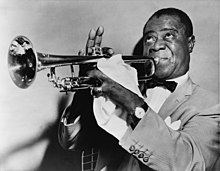|
Outline of jazz
The following outline is provided as an overview of and topical guide to jazz: Jazz – musical style that originated at the beginning of the 20th century in African American communities in the Southern United States, mixing African music and European classical music traditions. Jazz is a music genre that originated from African American communities of New Orleans in the United States during the late 19th and early 20th centuries. It emerged in the form of independent traditional and popular musical styles, all linked by the common bonds of African American and European American musical parentage with a performance orientation.[1] Jazz spans a period of over a hundred years, encompassing a very wide range of music, making it difficult to define. Jazz makes heavy use of improvisation, polyrhythms, syncopation and the swing note,[2] as well as aspects of European harmony, American popular music,[3] the brass band tradition, and African musical elements such as blue notes and African-American styles such as ragtime.[1] Although the foundation of jazz is deeply rooted within the black experience of the United States, different cultures have contributed their own experience and styles to the art form as well. Intellectuals around the world have hailed jazz as "one of America's original art forms".[4] As jazz spread around the world, it drew on different national, regional, and local musical cultures, which gave rise to many distinctive styles. New Orleans jazz began in the early 1910s, combining earlier brass-band marches, French quadrilles, biguine, ragtime and blues with collective polyphonic improvisation. In the 1930s, heavily arranged dance-oriented swing big bands, Kansas City jazz, a hard-swinging, bluesy, improvisational style and Gypsy jazz (a style that emphasized musette waltzes) were the prominent styles. Bebop emerged in the 1940s, shifting jazz from danceable popular music towards a more challenging "musician's music" which was played at faster tempos and used more chord-based improvisation. Cool jazz developed in the end of the 1940s, introducing calmer, smoother sounds and long, linear melodic lines. The 1950s saw the emergence of free jazz, which explored playing without regular meter, beat and formal structures, and in the mid-1950s, hard bop emerged, which introduced influences from rhythm and blues, gospel, and blues, especially in the saxophone and piano playing. Modal jazz developed in the late 1950s, using the mode, or musical scale, as the basis of musical structure and improvisation. Jazz-rock fusion appeared in the late 1960s and early 1970s, combining jazz improvisation with rock music's rhythms, electric instruments and the highly amplified stage sound. In the early 1980s, a commercial form of jazz fusion called smooth jazz became successful, garnering significant radio airplay. Other styles and genres abound in the 2000s, such as Latin and Afro-Cuban jazz. Types of jazzJazz can be described as all of the following:
Musical instruments typically associated with jazz
Jazz genresJazz fusionRegional scenesLocal scenesJazz compositionsJazz standards
Jazz discographies
History of jazzStylistic originsCultural origins
Mainstream popularity
Derivatives
Years in jazzJazz cultureJazz organizationsJazz publicationsPersons influential in jazzJazz musiciansJazz musicians, by instrumentJazz musicians, by genreSee alsoReferences
External links
|
||||||||||||||||||||||||||||||
